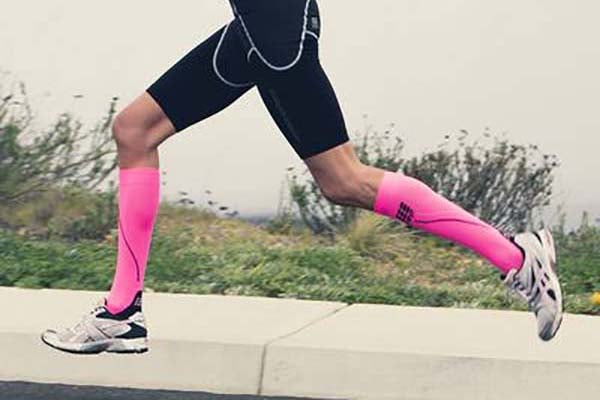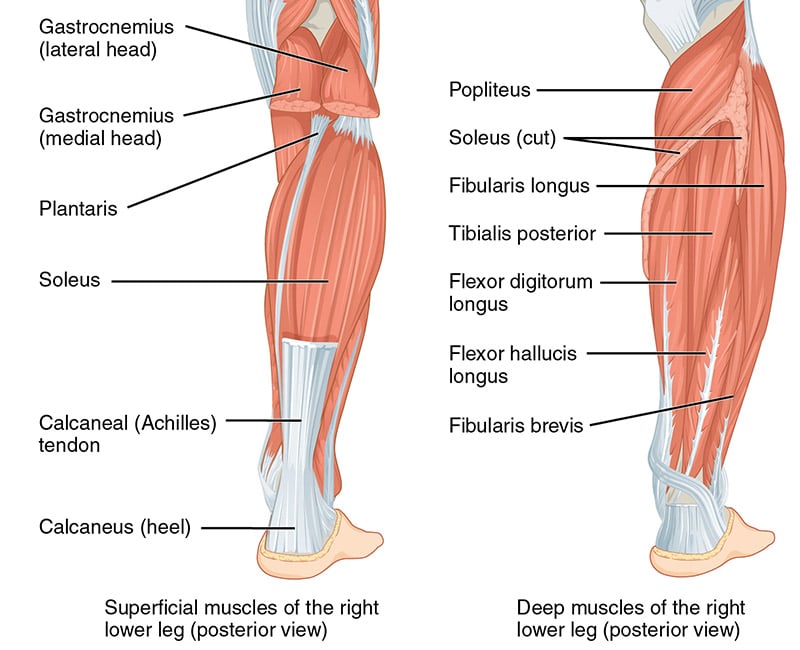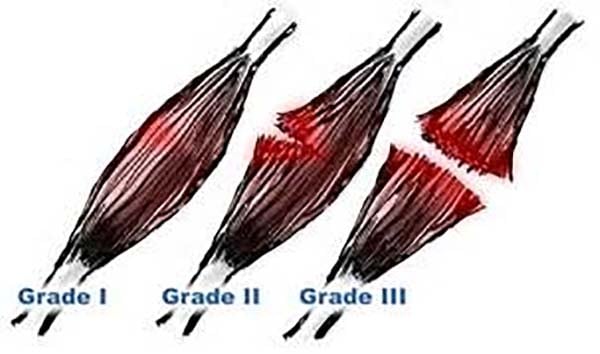Last Updated on
When is it appropriate to wear compression gear?
If you find yourself participating in a marathon, you might just see a handful of people wearing compression sleeves, socks, tights, and other various compression gear. These tight-fitting garments are thought to improve blood flow to the muscles by holding them firmly and thus potentially improving that marathon PR. It is not only marathoners that wear this gear, a multitude of other sport athletes will recommend compression gear as well. More and more athletes are wearing them during competition, games, or running events. But does it really improve athletic performance?
As far as runners, compression gear would be ideal on the lower leg. The calf muscles can be a pesky thing to deal with during those long runs and switching it up to speed workouts and tempo runs. To be specific let’s understand what the calf muscle is made up of.
Anatomy: Compartments of the Lower Leg
The lower leg in essence is made up of different compartments” the anterior compartment, the lateral compartment, the deep posterior compartment, and superficial posterior compartment. In all of these compartments some of the bulkiest muscles are the calf muscles which are found in the superficial posterior compartment. These muscles are made up of the gastrocnemius (the “meaty” part of the calf), the plantaris (a long and thin calf muscle) and the soleus (the lower end of the calf.) All these muscles that are found in that superficial posterior compartment transition into the Achilles tendon which attaches to the calcaneus (the heel bone.)
When it comes to running, the calves are a crucial thing to support you. They are also one of the first things to get fatigued when you start training or go into a heavier work load or phase of training. The calf muscle is in charge of plantar flexion of the foot (pointing your foot) and flexion (bending) of the knee. Injuries such as calf strains, peroneal tendinitis (the tendon that runs along the outside of the leg and calf that makes your foot turn out), achilles tendinitis, plantar fasciitis, and many others can occur when the calf muscles are strained.
Compression Gear Research
Compression gear has been worn during marathons and competitions by many professionals and recreational athletes with hopes that it will improve performance. In reality, research has shown that compression gear does not significantly enhance all aspects of your performance during competition. In the Kemmler et al, 2009 study on compression socks on running performance in male athletes, only slight differences were observed for VO2max. However, there was a significant difference anaerobic thresholds and aerobic thresholds. So, it could potentially be great when the compression gear is used in training and knowing you need to perform at different metabolic thresholds. Example workouts like this include track workouts or hill repeats.
To go back to the effect of performance in marathoners wearing compression socks, in Zaleski et al 2015 study, there were no significant time differences in these marathoners wearing compression versus not wearing compression. However, they did find that compression is helpful in overall hemostatic activation following marathon completion. With the Bringard et al 2006 study there was no significant effect on heart rate or plasma levels of lactate or creatine kinase (Ali et al 2010) during exercise as compared with no compression.
When it came to the effects of compression only worn during recovery, there were five studies performed (de Glanville and Hamlin, 2012; Driller and Halson, 2013, Menetrier et al, 2012; Sperlich et al, 2013; Trenell et al, 2006). The exercise was an endurance trial and athletes wore the compression gear during recovery. The study associated compression gear with lower plasma lactate levels as well as performance recovery in jumping, 40 m repeated sprint, isokinentic power, 3k run, and cycling.
Another great reason to use compression gear in recovery only is the effects of DOMS. DOMS is delayed onset muscle soreness which is great fatigue even days after a competition or a hard key workout. DOMS was found to be decreased by compression gear applied at 9.3 to 19.2 mmHg of pressure.
Wearing compression gear may not improve your race times much, but there are trends showing that compression is beneficial when worn for recovery purposes. Four out of six studied showed the DOMS was significantly reduced, and in seven studied, they reported that performance recovery was improved. The main reasons to wear compression gear in the recovery period is to decrease in muscular micro traumas, reduce edema, decrease vibrations, and help facilitate venous return and blood waste clearance. Success depends on the type of compression, its thickness, the body part, the sport, the athlete, the athlete level, age, sex, muscle mass, hydration, potential venous diseases. All these factors can affect the success of compression gear.
Application
So how does anatomy and compression gear tie into being a successful recreational or professional athlete? From an athletic training stand point, I would wear compression during a race if you end up having an injury. For example, if your goal race is in 2 weeks and you strain your calf training, compression wear will help you recover faster. Strains are when the fibers in the muscle tear. The effects of a strain can be described in grades such as Grade 1 being sharp when it first occurs at the time of injury. You are usually able to continue activity after a Grade 1 strain. You will have mild pain in one local spot with some spasm and swelling but your strength and range of motion should all still be intact or close.
A grade 2 is described as unable to continue when the injury happens, and there is a clear loss of strength and range of motion. The muscle fibers or torn greater than 10-15%. Grade 3 which would be immediate and severe pain causing disability in movement. You’ll be able to touch the calf and feel a defect in the muscle. With a grade 3 there is 50-100% tear in the muscle fibers. When this happens and if it happens close to a goal race, as an athletic trainer I would suggest wearing the compression gear on your calf strain if it is a grade 1 or 2. The compression gear can be very beneficial in keeping that muscle stable, lessening the vibration impact it takes while being active, decrease the swelling, and help with the healing process. It will get you through your race so you don’t just have to quit after all your hard work. Even if you decide to not compete after a calf strain, it would still be highly recommended to wear some sort of compression as you rehab through this injury.
Final Thoughts On Compression Gear
A calf strain is only an example of the application of anatomical structures I covered in this article. Compression gear can be used for different body parts, different muscular injuries, and for different reasons such as recovery from a race, or just getting through a race while not being 100%. Like stated before, there is still much more research that needs to be done, but in the end when compression is used appropriately, it can really facilitate you in your fitness goals.
















